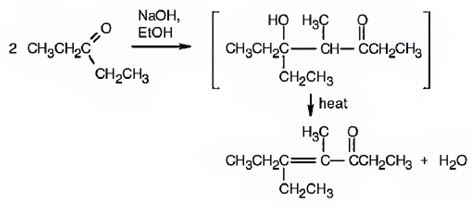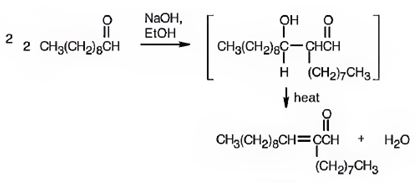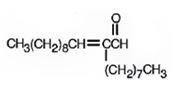
Concept explainers
a)

Interpretation:
Whether trimethylacetaldehyde undergoes aldol self-condensation reaction or not is to be stated. The product formed, if the reaction is successful, is also to be shown.
Concept introduction:
To state:
Whether trimethylacetaldehyde undergoes aldol self-condensation reaction or not.
To show:
The product formed, if the reaction is successful.
Answer to Problem 48AP
Trimethylacetaldehyde does not undergo aldol self-condensation reaction. The reaction is not successful.
Explanation of Solution
The requirement of aldol reaction is the aldehyde or ketone should have α-hydrogen atom. Trimethylacetaldehyde does not possess α-hydrogen atom. Hence the reaction is not successful.
Trimethylacetaldehyde does not undergo aldol self-condensation reaction. The reaction is not successful.
b)

Interpretation:
Whether cyclobutanone undergoes aldol self-condensation reaction or not is to be stated. The product formed, if the reaction is successful, is also to be shown.
Concept introduction:
Aldehydes and ketones with α-hydrogen undergo a base catalyzed carbonyl condensation reaction in aldol condensation. In this reaction two molecules of the reactant combine by forming a bond between α-carbon of one molecule and the carbonyl carbon within the same molecule or of the second molecule.
To state:
Whether cyclobutanone undergoes aldol self-condensation reaction or not.
To show:
The product formed, if the reaction is successful.
Answer to Problem 48AP
Cyclobutanone undergoes aldol self-condensation reaction. The product formed is

Explanation of Solution
The requirement of aldol reaction is the aldehyde or ketone should have α-hydrogen atom. Cyclobutanone has α-hydrogen atoms. Hence the reaction is successful. Two molecules of cyclobutanone condense in the presence of a base to yield an aldol which dehydrates to give α, β-unsaturated ketone.

Cyclobutanone undergoes aldol self-condensation reaction. The product formed is

c)

Interpretation:
Whether benzophenone undergoes aldol self-condensation reaction or not is to be stated. The product formed, if the reaction is successful, is also to be shown.
Concept introduction:
Aldehydes and ketones with α-hydrogen undergo a base catalyzed carbonyl condensation reaction in aldol condensation. In this reaction two molecules of the reactant combine by forming a bond between α-carbon of one molecule and the carbonyl carbon within the same molecule or of the second molecule.
To state:
Whether benzophenone undergoes aldol self-condensation reaction or not.
To show:
The product formed, if the reaction is successful.
Answer to Problem 48AP
Benzophenone does not undergo self aldol condensation reaction. The reaction is not successful.
Explanation of Solution
The requirement of aldol reaction is the aldehyde or ketone should have α-hydrogen atom. Benzophenone does not possess α-hydrogen atom. Hence the reaction is not successful.
Benzophenone does not undergo self aldol condensation reaction. Theb reaction is not successful.
d)

Interpretation:
Whether 3-pentanone undergoes aldol self-condensation reaction or not is to be stated. The product formed, if the reaction is successful, is also to be shown.
Concept introduction:
Aldehydes and ketones with α-hydrogen undergo a base catalyzed carbonyl condensation reaction in aldol condensation. In this reaction two molecules of the reactant combine by forming a bond between α-carbon of one molecule and the carbonyl carbon within the same molecule or of the second molecule.
To state:
Whether 3-pentanone undergoes aldol self-condensation reaction or not.
To show:
The product formed, if the reaction is successful.
Answer to Problem 48AP
3-pentanone undergoes aldol self-condensation reaction. The product formed is

Explanation of Solution
The requirement of aldol reaction is the aldehyde or ketone should have α-hydrogen atom. 3-Pentanone has α-hydrogen atom. Hence the reaction is successful. Two molecules of 3-pentanone condense in the presence of a base to yield an aldol which dehydrates to give the α, β-unsaturated ketone.

3-pentanone undergoes aldol self-condensation reaction. The product formed is

e)

Interpretation:
Whether decanal undergoes aldol self-condensation reaction or not is to be stated. The product formed, if the reaction is successful, is also to be shown.
Concept introduction:
Aldehydes and ketones with α-hydrogen undergo a base catalyzed carbonyl condensation reaction in aldol condensation. In this reaction two molecules of the reactant combine by forming a bond between α-carbon of one molecule and the carbonyl carbon within the same molecule or of the second molecule.
To state:
Whether decanal undergoes aldol self-condensation reaction or not.
To show:
The product formed, if the reaction is successful.
Answer to Problem 48AP
Decanal undergoes aldol self-condensation reaction. The product formed is

Explanation of Solution
The requirement of aldol reaction is the aldehyde or ketone should have α-hydrogen atom. Decanal has α-hydrogen atom. Hence the reaction is successful. Two molecules of decanal condense in the presence of a base to yield an aldol which dehydrates to give an α, β-unsaturated aldehyde.

Decanal undergoes aldol self-condensation reaction. The product formed is

f)

Interpretation:
Whether 3-phenyl-2-propenal undergoes aldol self-condensation reaction or not is to be stated. The product formed, if the reaction is successful, is also to be shown.
Concept introduction:
Aldehydes and ketones with α-hydrogen undergo a base catalyzed carbonyl condensation reaction in aldol condensation. In this reaction two molecules of the reactant combine by forming a bond between α-carbon of one molecule and the carbonyl carbon within the same molecule or of the second molecule.
To state:
Whether 3-phenyl-2-propenal undergoes aldol self-condensation reaction or not.
To show:
The product formed, if the reaction is successful.
Answer to Problem 48AP
3-Phenyl-2-propenal does not undergo aldol self-condensation reaction. The reaction is not successful.
Explanation of Solution
The requirement of aldol reaction is the aldehyde or ketone should have α-hydrogen atom. 3-Phenyl-2-propenal does not possess α-hydrogen atom. Hence the reaction is not successful.
3-Phenyl-2-propenal does not undergo aldol self-condensation reaction. The reaction is not successful.
Want to see more full solutions like this?
Chapter 23 Solutions
Student Value Bundle: Organic Chemistry, + OWLv2 with Student Solutions Manual eBook, 4 terms (24 months) Printed Access Card (NEW!!)
- Give the IUPAC name for this compound Hydrocarbon Condensed Formulas Hint C2H5 CH2CH3 expand that in all the formula Part A: (CH3)2CHCH(C2H5)CH2CH2CH3 Give the IUPAC name for this compound. Part B: CH2=C(C2H5)CH2CH2CH3 Give the IUPAC name for this compound. Part C: (CH3)2C=CHC(C2H5)=CH2 Give the IUPAC name for this compound. Part D: CH3C=CCH(C2H5)2 Give the IUPAC name for this compound. Part E: (CH3)3CC=CCH2CH=C(CH3)2arrow_forwardSelect/ Match the correct letter from the image below for the IUPAC names given below: A B C D 3 E F G H K L Part 1. 4-methylheptane For example.mmmm Answer Letter H _for part 1 Part 2. 2,4-dimethylhexane Part 3. 2,3-dimethylpentane Part 4. 2,2-dimethylhexane Part 5. 2-ethyl-1,1,3,3-tetramethylcyclopentane Part 6. 3-ethyl-2-methylpentanearrow_forwardCan u show the process as to how to get these?arrow_forward
- Sketch the expected 'H NMR spectra for the following compound. Label all of the H's in the structure and the corresponding signal for the spectra you sketch. Make sure you include the integration value and the splitting pattern for each signal Indicate how many signals you would expect in the 13C NMRarrow_forwardUse IUPAC naming rules to name the following hydrocarbon compounds: CH2-CH3 | a) CH-CH-CH2-CH-CH-CH3 b) | CH2 CH3 | CH3 CH3 \ / C=C H 1 H CH2-CH3 c) d) CH=C-CH3 e) CH3-CH2-CH2-CH=CH-CH3 f) CH2=CH-CH2-CH=CH-CH3 g) CH3-CH2-C = C-CH2-CH3 h)arrow_forwardQ5 Name the following : a. b. C. d. e.arrow_forward
- 25. Predict the major product of the following reaction. 1 equivalent of each of the starting materials was used. H₂C CH3 CH3 H3C H3C H3C. CH2 + H3C. heat CH3 CH H.C. CH3 H.C H.C CH3 CH CH3 CH3 A B C Earrow_forwardFind chemical structures based on the below information. a) Chemical formula C6H8O Compound is aromatic plus has two 1H NMR peaks that integrated for 3 each that are singlets (it could have more peaks in the 1H NMR b) Chemical Formula: C6H100 Compounds is conjugated 'H NMR has a signal that integrates for 6 and is a doublet IR spectra has a signal at 1730 cm-1arrow_forwardJaslev Propose a synthesis of the following starting from benzene and any other reagents and chemicals. No mechanisms are required. Indicate the condition for each step plus the major product for each step. More than two steps are required. Step 1 Step 2 مہد Brarrow_forward
- Part C: The line formula for another branched alkane is shown below. i. In the IUPAC system what is the root or base name of this compound? ii. How many alkyl substituents are attached to the longest chain? iii. Give the IUPAC name for this compound.arrow_forwardPart D: Draw the Structural Formula for 4-ethyl-2-methylhexane Part E. Draw the Structural Formula for 1-chloro-3,3-diethylpentane (Chloro = Cl)arrow_forwardPart B: The line formula for a branched alkane is shown below. a. What is the molecular formula of this compound? Number of C. Number of H b. How many carbon atoms are in the longest chain? c. How many alkyl substituents are attached to this chain?arrow_forward
 Organic ChemistryChemistryISBN:9781305580350Author:William H. Brown, Brent L. Iverson, Eric Anslyn, Christopher S. FootePublisher:Cengage Learning
Organic ChemistryChemistryISBN:9781305580350Author:William H. Brown, Brent L. Iverson, Eric Anslyn, Christopher S. FootePublisher:Cengage Learning

